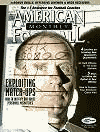AMERICAN FOOTBALL MONTHLY THE #1 RESOURCE FOR FOOTBALL COACHES
Article CategoriesAFM Magazine
|
The Scouting Reportby: Mark Speckman© More from this issue Mark Speckman has been coaching Willamette University football for the past eight years. The Bearcats are 46-34 under Speckman and in 1999 he was named Northwest Conference Coach of the Year after Willamette won the NWC title and earned a trip to the D III national playoffs. Speckman was the Bearcats’ offensive coordinator for three years prior to being named head coach. He also spent 14 seasons as a high school head football coach, compiling an overall mark of 113-48-3. But he’s more than just a coach. Mark Speckman is a teacher and motivational speaker and someone who has learned to turn the adversity life has dealt him into a positive affirmation. Born without hands, Speckman has taken his physical liability and turned it into a positive. Speckman was an honorable mention NAIA All-America linebacker at Azusa Pacific....The full article can only be seen by subscribers. Subscribe today!
|
|
|||||||
| HOME |
MAGAZINE |
SUBSCRIBE | ONLINE COLUMNISTS | COACHING VIDEOS |
Copyright 2025, AmericanFootballMonthly.com
All Rights Reserved





